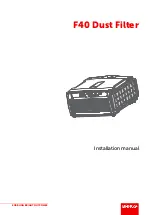
6
ECOWATER
S
Y
S
T
E
M
S
Water, and Water Conditioning
2. IRON in water is measured in parts per million (ppm). The total* ppm of iron, and type or types*, is determined
by chemical analysis. Four different types of iron in water are:
¡
Ferrous (clear water),
©
Ferric (red water),
¢
Bacterial and organically bound iron,
£
Colloidal and inorganically bound iron (ferrous or ferric).
*Water may contain one or more of the four types of iron and any combination of these. Total iron is the sum
of the contents.
¡
Ferrous (clear water) iron is soluble and dissolves in water. It is usually detected by taking a sample of water
in a clear bottle or glass. Immediately after taking, the sample is clear. As the water sample stands, it gradually
clouds and turns slightly yellow or brown as air oxidizes the iron. This usually occurs in 15 to 30 minutes. This
unit will remove moderate amounts of this type of iron (see specifications).
When using the softener to remove Ferrous (clear water) iron, add 5 grains
!
to the hardness setting
for every 1 ppm of Ferrous (clear water) iron.
!
1 gpg = 0.959
_
d = 1.71
_
F
©
Ferric (red water), and
¢
Bacterial and organically bound irons are insoluble. This iron is visible
immediately when drawn from a faucet because it has oxidized before reaching the home. It appears as small
cloudy yellow, orange, or reddish suspended particles. After the water stands for a period of time, the particles
settle to the bottom of the container. Generally these irons are removed from water by filtration. Chlorination
is also recommended for bacterial iron. This unit will not remove ferric or bacterial iron.
£
Colloidal and inorganically bound iron is of ferric or ferrous form that will not filter or exchange out of water.
In some instances, treatment may improve colloidal iron water, but always CONSULT A QUALIFIED WATER
CHEMISTRY LAB before attempting to treat it. Colloidal iron water usually has a yellow appearance when
drawn. After standing for several hours, the color persists and the iron does not settle, but remains suspended
in the water.
Iron in water causes stains on clothing and plumbing fixtures. It negatively affects the taste of food, drinking
water, and other beverages. This unit will not remove colloidal iron.
3. ACIDITY or acid water is caused by carbon dioxide, hydrogen sulfide, and sometimes industrial wastes. It is
corrosive to plumbing, plumbing fixtures, water heaters, and other water using appliances. In can also
damage and cause premature failure of seals, diaphragms, etc., in water handling equipment.
A chemical analysis is needed to measure the degree of acidity in water. This is called the pH of water. Water
testing below 6.9 pH is acidic. The lower the pH reading, the greater the acidity. A neutralizer filter or a
chemical feed pump are usually recommended to treat acid water.
4. SEDIMENT is fine, foreign material particles suspended in water. This material is most often clay or silt.
Extreme amounts of sediment may give the water a cloudy appearance. A sediment filter installed ahead
of the water softener normally corrects this situation.







































